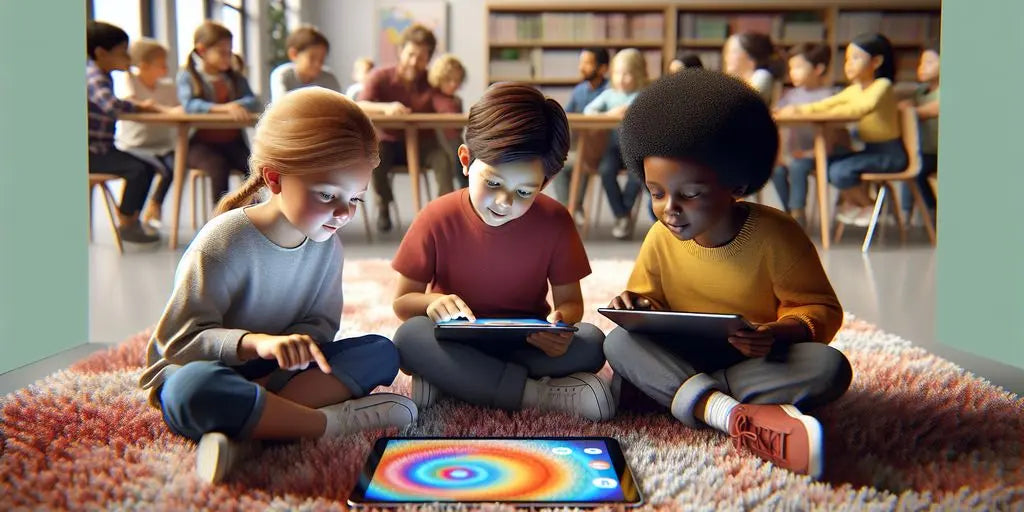Autism Spectrum and Technology: Helpful Apps

In the digital age, technology plays a pivotal role in enhancing the lives of individuals on the autism spectrum. Apps specifically designed or suitable for autism can significantly improve communication, learning, and daily functioning. These tools provide a unique blend of interactive and customizable features tailored to meet the diverse needs of autistic individuals across different ages and abilities.
Key Takeaways
- Autism apps are essential tools that aid in communication, learning, and behavior management.
- They offer customizable features to suit individual needs, enhancing usability and effectiveness.
- Educational and social skills development apps incorporate interactive and engaging methods to facilitate learning.
- Behavioral and sensory apps provide support for managing daily challenges and improving quality of life.
- Future trends in autism apps include the integration of AI, augmented reality, and user-centric designs to enhance user experience.
Understanding Autism and Technology
Role of Technology in Autism
For individuals with autism, technology can offer a range of benefits. It provides a platform for self-expression, social interaction, and learning in a way that is engaging and accessible. Many individuals with autism find technology to be non-threatening and predictable, making it easier to navigate and explore. Additionally, technology has the capacity to adapt and personalize content, catering to the unique needs and abilities of each individual.
Benefits of Apps for Autism
Technology has become an invaluable tool in the lives of individuals with autism, offering numerous benefits and opportunities for communication and learning. With the advent of smartphones and tablets, autism apps have emerged as a valuable resource for children and adults on the autism spectrum. These apps can aid in communication, skill development, and overall quality of life. Because so many autistic people are more comfortable with technology than with people, it is easy to allow technology to take over. Caregivers (and autistic people themselves) should work hard to carefully select the apps that are appropriate to their particular needs, and to supplement their use with plenty of real-world interactions.
Integration with Daily Life
Technology has significantly impacted our daily lives, in some ways for the better, and some ways for the worse. Whatever your feelings may be about our increasingly digital world, there are definite advantages of incorporating technology in applied behavior analysis therapy, particularly through the use of apps for autism. Many schools now provide adaptive technology (or assistive technology) for children who are on the autism spectrum, which provide useful tools for building cognitive
Best Apps for Autism
Criteria for Selection
Selecting the best apps for autism involves considering several key factors such as user-friendliness, effectiveness, and the ability to customize features to meet individual needs. The most successful apps often integrate seamlessly with daily routines, providing a smooth user experience without overwhelming the user.
Top Rated Apps
The market offers a plethora of apps designed to assist individuals with autism. Here are a few top-rated apps:
- Proloquo2Go: A symbol-based communication app.
- The Social Express: Interactive software focusing on social skills development.
- Model Me Going Places: Visual teaching tool for children to help them navigate various social scenarios.
User Reviews and Feedback
User feedback is crucial in evaluating the effectiveness of autism apps. Positive reviews often highlight ease of use and the tangible benefits seen in daily life. However, it's important to consider a range of opinions to understand any potential limitations or issues.
Note: Always consult with a healthcare professional before integrating new technological tools into therapeutic practices.
Communication Enhancement Apps
Visual and Audio Support
Visual and audio supports are integral to communication apps designed for individuals on the autism spectrum. These features can include everything from simple pictograms to complex scenes that help convey thoughts and emotions. The use of visual schedules and social stories can significantly aid in understanding social cues and sequences of events, making daily communications smoother and more predictable.
Customizable Interfaces
The ability to customize interfaces allows users to tailor the app to their specific needs and preferences. This flexibility is crucial for creating a comfortable and effective communication environment. Customization can range from changing color schemes to adjusting the layout of communication buttons. Such personalized settings help enhance the user experience and promote better engagement.
Real-time Interaction Features
Real-time interaction features in communication apps enable immediate feedback and interaction, which is essential for learning and practicing new communication skills. Features like live chat functions and video calling can mimic face-to-face interactions, providing practical experience in real-world social settings. This immediacy can be particularly beneficial in therapy sessions or daily communication practice, helping to build confidence and improve communication skills over time.
Educational Apps for Autism
Learning Through Play
Interactive and multisensory learning is at the heart of educational apps designed for autism. These apps leverage play to teach various academic skills, making learning both fun and effective. They often include games and activities that are tailored to enhance cognitive development and cater to the unique learning needs of individuals on the spectrum.
Curriculum-based Apps
These apps align with standard educational curricula, providing structured learning paths in subjects like math, reading, and science. The use of visual supports and interactive elements helps to break down complex concepts into manageable parts, making them more accessible for learners with autism.
Interactive Learning Tools
Educational apps for autism excel in offering real-time feedback and interactive features that allow for an engaging learning experience. This not only helps in retaining attention but also in reinforcing learning through immediate correction and encouragement. The ability to customize settings and content ensures that each learner's individual needs and preferences are met, promoting a more personalized learning journey.
Social Skills Development Apps
Role-playing Scenarios
Role-playing scenarios in apps provide a safe and controlled environment for individuals with autism to practice and enhance their social interactions. These scenarios can simulate various social situations, allowing users to experiment with different responses and learn appropriate social behaviors. This hands-on approach is crucial for building confidence in social settings.
Feedback Mechanisms
Feedback mechanisms in social skills apps are essential for learning and improvement. They provide immediate and personalized feedback on the user's performance, helping them understand and rectify their social interactions. This continuous feedback loop enables users to make rapid progress in their social skills development.
Peer Interaction Facilitation
Facilitating peer interactions through apps can significantly boost the social skills of individuals with autism. By connecting users with peers in similar situations, these apps foster a sense of community and shared learning. Interactive features such as chat functions, shared activities, and group challenges encourage active participation and collaboration among users.
Behavioral Management Apps
Behavioral management apps are essential tools for individuals on the autism spectrum, helping them to develop self-regulation skills, improve emotional well-being, and reduce anxiety. These apps often include features like visual timers, emotion recognition activities, relaxation techniques, and behavior tracking tools.
Goal Setting and Tracking
Goal setting and tracking are fundamental in behavioral management. Apps like HabitRPG encourage users by gamifying the habit-building process. Users earn points for completing good habits and avoiding bad ones, making it a fun and engaging way to develop positive routines.
Positive Reinforcement Tools
Positive reinforcement is a key strategy in behavioral management. Apps like Birdhouse for Autism allow caregivers to track behaviors and health, identifying patterns that help in adjusting daily schedules for better outcomes. The use of positive reinforcement tools in these apps aids in teaching skills and shaping behavior effectively.
Data Analysis and Reporting
Data-driven insights are crucial for effective behavioral management. Apps provide detailed reports and analytics that help in understanding the impact of various interventions on behavior. This information is vital for caregivers and professionals to fine-tune strategies and ensure optimal support for individuals with autism.
Sensory Support Apps
Soothing Sounds and Visuals
For individuals on the autism spectrum, sensory overload can be a daily challenge. Apps that provide soothing sounds and visuals can be a lifeline, offering a calming effect when needed. These apps often feature a range of visual stimming options, such as gentle color transitions or nature scenes, paired with soft, ambient sounds. These elements work together to create a serene environment that can help reduce anxiety and sensory overload.
Customizable Settings
The ability to customize settings is crucial for meeting the diverse sensory needs of autistic individuals. Apps that allow users to adjust sound levels, visual patterns, and timing offer a personalized experience that can be tailored to each user’s specific preferences. This flexibility ensures that the apps can be used in various settings, from quiet time at home to stressful situations outside.
Usage in Daily Routines
Incorporating sensory support apps into daily routines can significantly enhance the quality of life for those with autism. These apps can be used as part of a morning routine to set a calm tone for the day, or in the evening to wind down before bed. Regular use of these apps can help establish a comforting routine that makes daily transitions smoother and less stressful.
Parent and Caregiver Support Apps
Resource Sharing
In the digital age, sharing resources efficiently is crucial for parents and caregivers of individuals with autism. Apps designed for resource sharing can significantly ease the burden by providing instant access to essential tools, educational materials, and community advice. These platforms often feature downloadable content, interactive forums, and links to critical services, making them invaluable in managing daily challenges.
Monitoring and Alerts
Stay ahead with real-time monitoring and alerts. Apps in this category offer functionalities that allow caregivers to keep a close eye on the safety and well-being of their loved ones. From location tracking to behavior monitoring, these apps send instant notifications to ensure peace of mind. The integration of these tools into daily routines can transform the caregiving experience, offering both security and independence to users.
Community and Support Networks
Connecting with others in similar situations can be a lifeline for many parents and caregivers. Apps focusing on building community and support networks provide platforms where individuals can exchange practical tips, share experiences, and find emotional support. These networks not only foster a sense of belonging but also offer access to a wealth of collective knowledge and coping strategies.
Making the Most of Autism Apps
Customization Tips
To truly benefit from autism apps, it's crucial to tailor them to meet individual needs. By exploring the vast selection of apps available, users can find those that best align with their specific requirements and preferences. Customizing settings and content ensures that the app serves its purpose effectively, enhancing the user experience and maximizing its utility.
Balancing Screen Time
While autism apps can be highly beneficial, it's important to maintain a healthy balance between screen time and other activities. Structuring the use of these apps within daily routines helps prevent over-reliance on digital interactions, promoting a well-rounded lifestyle. Remember, apps are just one part of a broader approach to supporting individuals with autism.
Engagement Strategies
Engaging effectively with autism apps involves more than just regular use. It requires active and thoughtful interaction. Strategies such as setting clear objectives for app use, and integrating the apps into educational and developmental activities, can greatly enhance their impact. This proactive approach helps in achieving the desired outcomes, making the technology an integral part of learning and development.
Apps for Adults on the Autism Spectrum
Life Skills Development
Adults on the autism spectrum often face unique challenges in managing daily activities and responsibilities. Apps designed for life skills development can provide essential support, helping to structure routine tasks and improve independence. Features like task reminders, budgeting tools, and step-by-step guides for various activities are particularly beneficial.
Employment and Task Management
Navigating the workplace can be daunting for adults with autism. Apps that assist with employment and task management are crucial. They offer structured schedules, detailed task breakdowns, and the ability to set timers for work segments, making the work environment more manageable and less overwhelming.
Social and Communication Tools
Effective communication and social interaction can be challenging for adults with autism. Apps focusing on these areas often include role-playing scenarios, real-time feedback, and options to rehearse social situations in a controlled environment. This helps users to build confidence and improve their social skills gradually.
Innovative Features in Autism Apps
AI and Machine Learning
Artificial Intelligence (AI) and machine learning are revolutionizing autism apps by enabling them to adapt to the user's behavior and needs. These technologies can analyze data from user interactions to personalize the learning experience and provide predictive insights that help in skill development and behavioral management.
Augmented Reality
Augmented reality (AR) brings a new dimension to autism apps by overlaying digital information onto the real world. This feature can make learning more engaging for individuals with autism by providing sensory experiences that are otherwise difficult to grasp. AR can be particularly effective in teaching social cues and environmental understanding.
Adaptive Learning Algorithms
Adaptive learning algorithms adjust the difficulty level and the type of content based on the user's progress and performance. This ensures that each individual has a tailored learning experience that is both challenging and achievable. Adaptive algorithms help maintain engagement and maximize learning outcomes by continuously challenging the user at the right level.
By integrating innovative features like AI, AR, and adaptive algorithms, autism apps are becoming more effective tools for education and development.
Future Trends in Autism and Technology
Emerging Technologies
The landscape of autism support through technology is ever-evolving, with emerging technologies playing a pivotal role. Innovations such as virtual reality and advanced sensory devices are set to enhance therapeutic environments, making them more immersive and effective. These technologies aim to simulate real-world scenarios in a controlled manner, helping individuals on the autism spectrum to develop coping strategies in a safe setting.
Research and Development
The commitment to research and development in the autism technology sector is robust, with numerous studies focusing on enhancing the effectiveness of existing apps and exploring new possibilities. This ongoing research is crucial for tailoring interventions to the unique needs of individuals with autism, ensuring that technology remains a relevant and powerful tool for support.
User-Centric Design
In the realm of autism apps, user-centric design is paramount. Developers are increasingly focusing on creating intuitive interfaces that cater to the sensory and cognitive needs of autistic users. This approach not only improves usability but also ensures that the apps are more engaging and beneficial. The future will likely see a surge in apps that are not only functional but also highly personalized, reflecting the diverse experiences of those on the autism spectrum.
Conclusion
In conclusion, the integration of technology in the form of apps has proven to be a significant boon for individuals on the autism spectrum. These apps not only enhance communication and learning but also provide essential tools for skill development and emotional regulation. As we've explored various types of apps—from communication aids to sensory tools—it's clear that technology can be tailored to meet the diverse needs of the autism community. It's important for users to select apps that suit their specific requirements and to maintain a balanced approach to screen time. With the right resources and usage, technology can continue to be a valuable ally in improving the quality of life for those with autism.
Frequently Asked Questions
What are autism apps?
Autism apps are mobile or desktop applications designed to aid individuals with autism in communication, skill development, and daily living. They can include features for enhancing communication, teaching social skills, managing behavior, and providing sensory support.
How do autism apps help with communication?
Autism apps often provide visual cues, interactive features, and customizable settings that help individuals express their needs, thoughts, and emotions, enhancing their ability to interact socially and build meaningful connections.
What types of autism apps are available?
There are various types of autism apps including communication tools, social skills teaching tools, behavioral management tools, sensory support apps, and educational apps focused on different learning approaches.
Can autism apps be customized?
Yes, many autism apps allow customization to suit the individual preferences and abilities of the user, making them more effective and user-friendly.
How should one choose an autism app?
When choosing an autism app, consider the specific needs and goals of the user, the app's features, user reviews, and feedback. It's also important to ensure the app is easy to use and aligns with therapeutic goals if applicable.
Are there autism apps for adults as well as children?
Yes, there are autism apps designed for both children and adults. Apps for adults often focus on life skills development, employment, and task management, along with social and communication tools.
What is the role of technology in improving the lives of individuals with autism?
Technology, particularly through the use of apps, plays a crucial role in providing accessible tools for communication, learning, and daily living, thereby improving the overall quality of life for individuals with autism.
What should be considered when integrating autism apps into daily life?
When integrating apps into daily life, it's important to find a healthy balance between screen time and other activities, customize the apps to individual needs, and ensure they complement therapeutic and educational goals.



